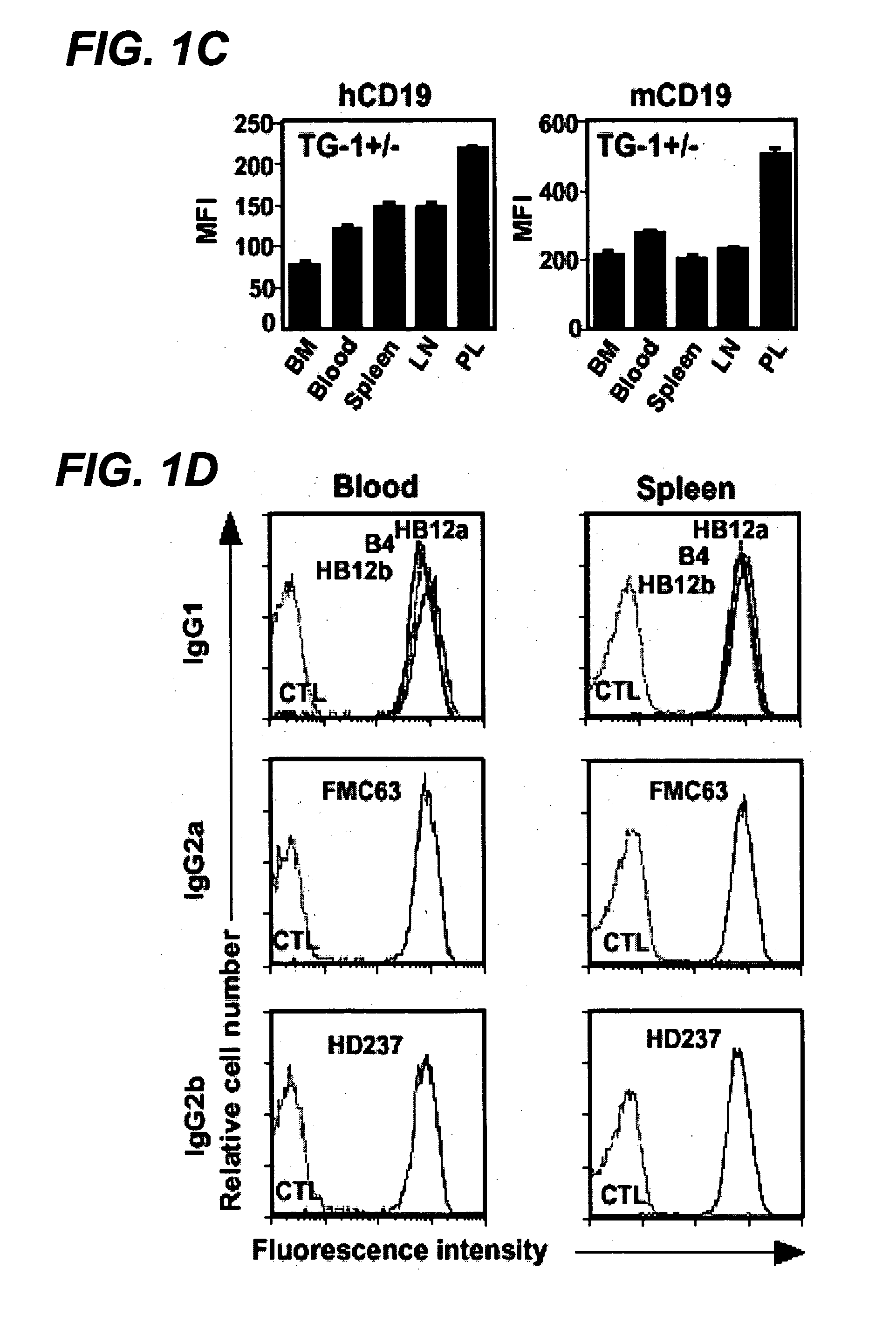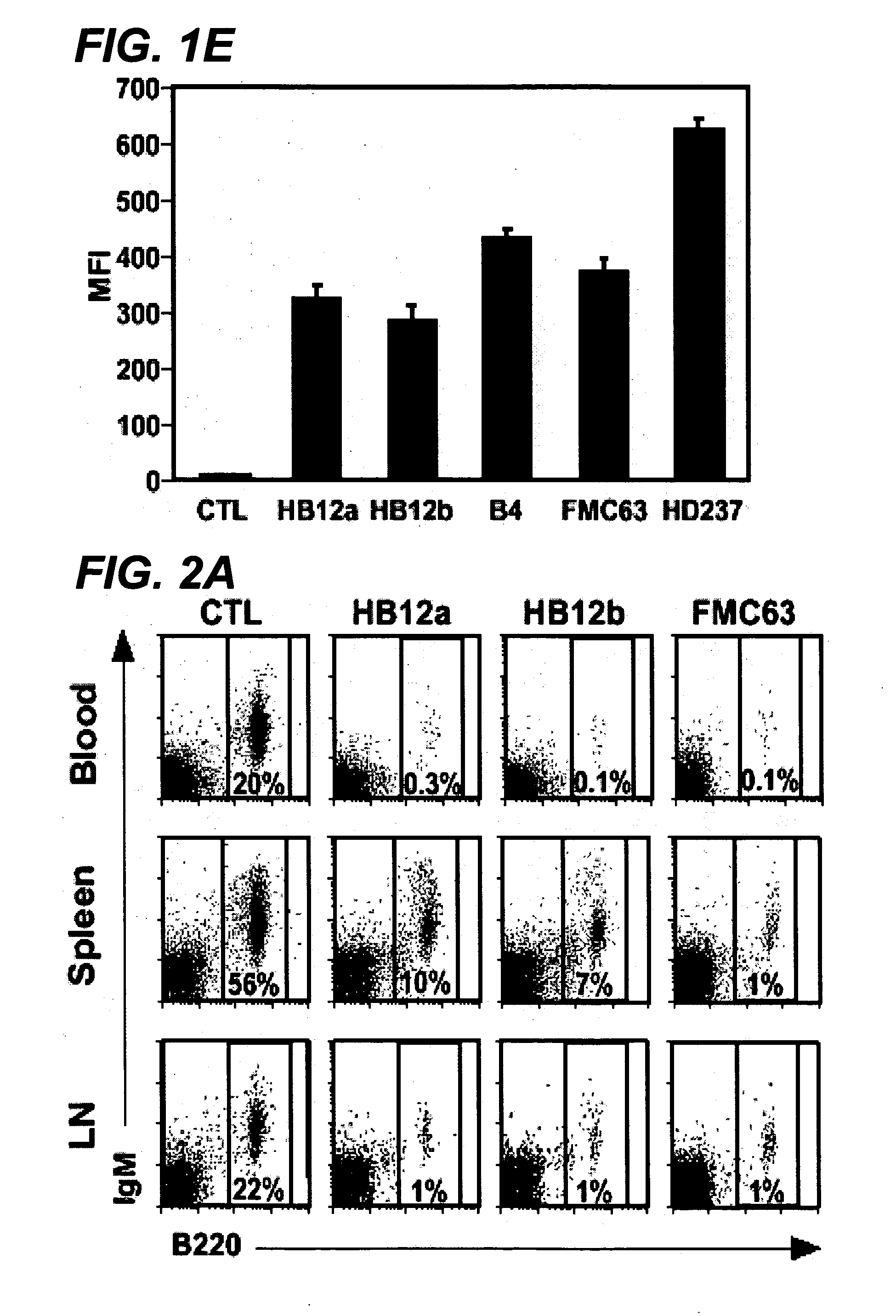Anti-CD19 antibody therapy for transplantation
a technology of anti-cd19 antibody and transplantation, which is applied in the field of anti-cd19 antibody therapy for transplantation, can solve the problems of limiting the use of transplantation immunotherapy, the current therapeutic agent and strategy for targeting humoral immunity is less well developed than that for targeting cellular immunity, and the graft is quickly destroyed
- Summary
- Abstract
- Description
- Claims
- Application Information
AI Technical Summary
Benefits of technology
Problems solved by technology
Method used
Image
Examples
example 1
6.2. Example 1
Human CD19 Expression in Transgenic Mice
[0402] The transgenic hCD 19TG ;mice described herein or other transgenic animals expressing human CD19 can be used to assess different therapeutic regimens comprising human, humanized, or chimeric anti-CD19 antibodies, such as variations in dosing concentration, amount, or timing. The efficacy in human patients of different therapeutic regimens can be predicted using the two indicators described below, i.e., B cell depletion in certain bodily fluids and / or tissues and the ability of a monoclonal human or humanized anti-CD19 antibody to bind B cells. In particular embodiments, treatment regimens that are effective in human CD19 transgenic mice can be used with the compositions and methods of the invention to treat autoimmune diseases or disorders in humans.
[0403] In order to determine whether human CD19 was expressed on B cells from transgenic mice (hemizygous TG-1±) expressing the human CD19 transgene, B cells were extracted f...
example 2
6.3. Example 2
Anti-CD19 Antibody Depletion of B Cells in vivo
[0412] Mouse anti-CD19 antibodies (that bind to human CD19) were assessed for their ability to deplete hCD19TG (TG-1±) blood, spleen, and lymph node B cells in vivo. Each antibody was given to mice at either 250 or 50 μg / mouse, a single dose about 10 to 50-fold lower than the 375 mg / m2 dose primarily given four times for anti-CD20 therapy in humans (Maloney et al., J. Clin. Oncol., 15:3266-74(1997) and McLaughlin et al., 12:1763-9 (1998)).
[0413] The results are shown in FIG. 2A in a plot of B cell amount 7 days following CD19 or isotype-matched control (CTL) treatment with HB12a, HB12b, or FMC63 anti-CD19 antibodies or a control. Separate plots are provided for lymph nodes, spleen and blood tissues for each anti-CD19 antibody. The percentage of gated lymphocytes depleted at 7 days shown on each plot demonstrates representative B cell depletion from blood, spleen and lymph nodes of TG-1± mice as determined by immunofluore...
example 3
6.4. Example 3
Tissue B Cell Depletion is FCγR-Dependent
[0439] The following assays were used to determine whether B cell depletion by an anti-CD19 antibody was dependent on FcγR expression. Through a process of interbreeding hCD19tg with mice lacking expression of certain FcγR, mice were generated that expressed hCD19 and lacked expression of certain FcγR. Such mice were used in assays to assess the ability of anti-CD19 antibodies to deplete B cells through pathways that involve FcγR expression, e.g., ADCC. Thus, anti-CD19 antibodies identified in these assays can be used to engineer chimeric, human or humanized anti-CD19 antibodies using the techniques described above in Section 5.1. Such antibodies can in turn be used in the compositions and methods of the invention for the treatment of autoimmune diseases and disorders in humans.
[0440] The innate immune system mediates B cell depletion following anti-CD20 antibody treatment through FcγR-dependent processes. Mouse effector cells...
PUM
| Property | Measurement | Unit |
|---|---|---|
| Tm | aaaaa | aaaaa |
| Tm | aaaaa | aaaaa |
| Tm | aaaaa | aaaaa |
Abstract
Description
Claims
Application Information
 Login to View More
Login to View More - R&D
- Intellectual Property
- Life Sciences
- Materials
- Tech Scout
- Unparalleled Data Quality
- Higher Quality Content
- 60% Fewer Hallucinations
Browse by: Latest US Patents, China's latest patents, Technical Efficacy Thesaurus, Application Domain, Technology Topic, Popular Technical Reports.
© 2025 PatSnap. All rights reserved.Legal|Privacy policy|Modern Slavery Act Transparency Statement|Sitemap|About US| Contact US: help@patsnap.com



